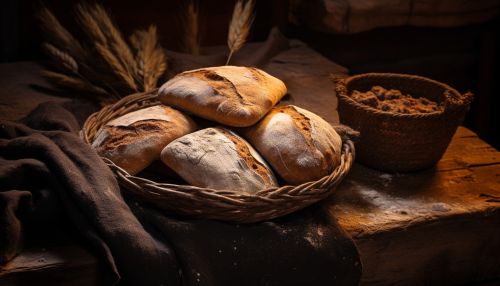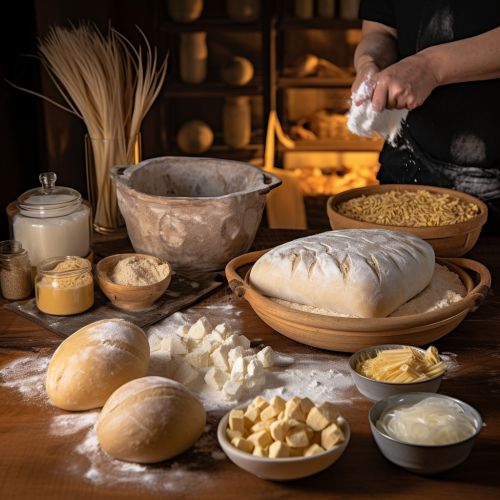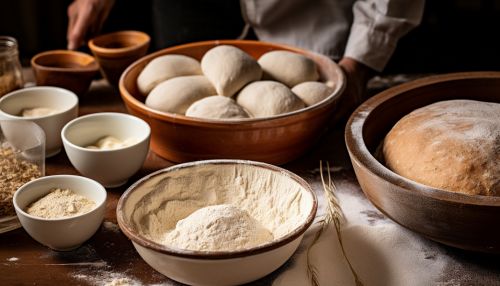Bread baking
History of Bread Baking
Bread baking is a process that dates back to the Neolithic era, when grains were crushed and mixed with water to form a paste. This paste was then cooked on hot stones, resulting in a flat, hard bread. The discovery of leavening, where dough is left to rise, marked a significant turning point in the history of bread baking. The Egyptians are often credited with the invention of leavened bread, which was likely a result of wild yeasts present in the air.


The process of bread baking continued to evolve with the invention of the oven, which allowed for more controlled and consistent baking conditions. The Greeks are often credited with the invention of the first known oven, and their love for bread is well-documented in historical texts. The Romans further refined the process, introducing the use of different types of flour and grains.
Ingredients and Their Roles
The basic ingredients used in bread baking are flour, water, yeast, and salt. Each ingredient plays a crucial role in the final product.
Flour provides the structure for the bread. The proteins in the flour combine to form gluten when mixed with water. This gluten network traps the carbon dioxide produced by the yeast, causing the dough to rise.
Water hydrates the flour, allowing the proteins to combine and form gluten. It also dissolves the yeast and salt, allowing them to be evenly distributed throughout the dough.
Yeast is a type of fungus that ferments the sugars in the flour, producing carbon dioxide and alcohol. The carbon dioxide causes the dough to rise, while the alcohol contributes to the flavor of the bread.
Salt enhances the flavor of the bread and also strengthens the gluten network, making the dough more elastic and less sticky.
Process of Bread Baking
The process of bread baking involves several steps: mixing, kneading, proofing, shaping, and baking.
During the mixing stage, the ingredients are combined to form a dough. The dough is then kneaded, which strengthens the gluten network and evenly distributes the yeast and salt.
The dough is then left to proof, or rise. During this stage, the yeast ferments the sugars in the flour, producing carbon dioxide and causing the dough to rise.
After the dough has risen, it is shaped into the desired form and left to rise again. This second rise, or proof, allows the dough to develop more flavor and texture.
Finally, the dough is baked in an oven. The heat causes the water in the dough to turn to steam, which expands and causes the dough to rise even further. The heat also caramelizes the sugars on the surface of the dough, resulting in a golden-brown crust.


Types of Bread
There are many different types of bread, each with its own unique characteristics. Some of the most common types include white bread, whole wheat bread, rye bread, and sourdough bread.
White bread is made from flour that has had the bran and germ removed. This results in a lighter, softer bread with a mild flavor.
Whole wheat bread is made from flour that includes the whole grain. This results in a denser, more flavorful bread with a higher fiber content.
Rye bread is made from rye flour, which has a distinct, slightly sour flavor. Rye bread is often denser and darker than other types of bread.
Sourdough bread is made using a sourdough starter, which is a mixture of flour and water that has been fermented. This results in a bread with a tangy flavor and a chewy texture.
Health and Nutrition
Bread is a staple food in many cultures and provides a significant amount of the daily recommended intake of carbohydrates. It also provides some protein, vitamins, and minerals, although the exact nutritional content varies depending on the type of bread.
Whole grain breads, such as whole wheat and rye, are generally considered healthier than white bread. They contain more fiber and nutrients, and have a lower glycemic index, which means they cause a slower rise in blood sugar levels.
However, bread is also high in calories and carbohydrates, and low in fat and protein. This means that while it can be part of a healthy diet, it should be eaten in moderation, especially for individuals who are trying to lose weight or manage their blood sugar levels.
